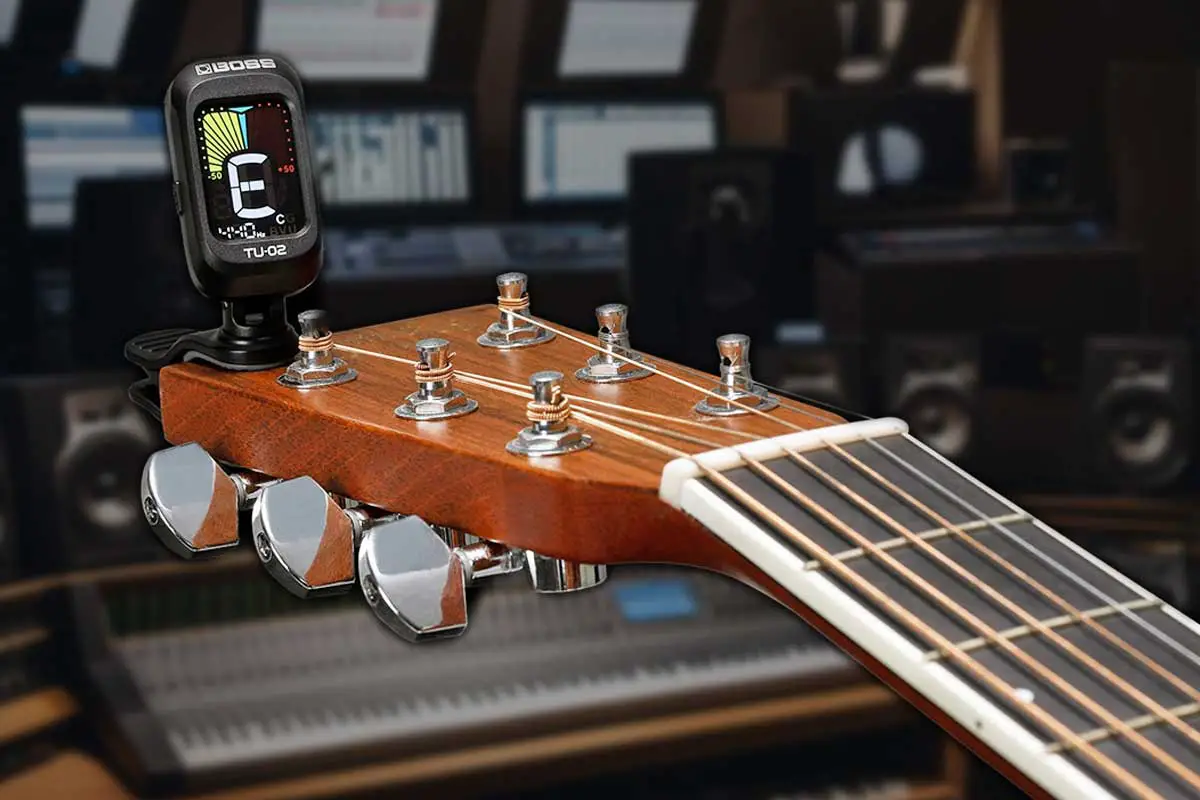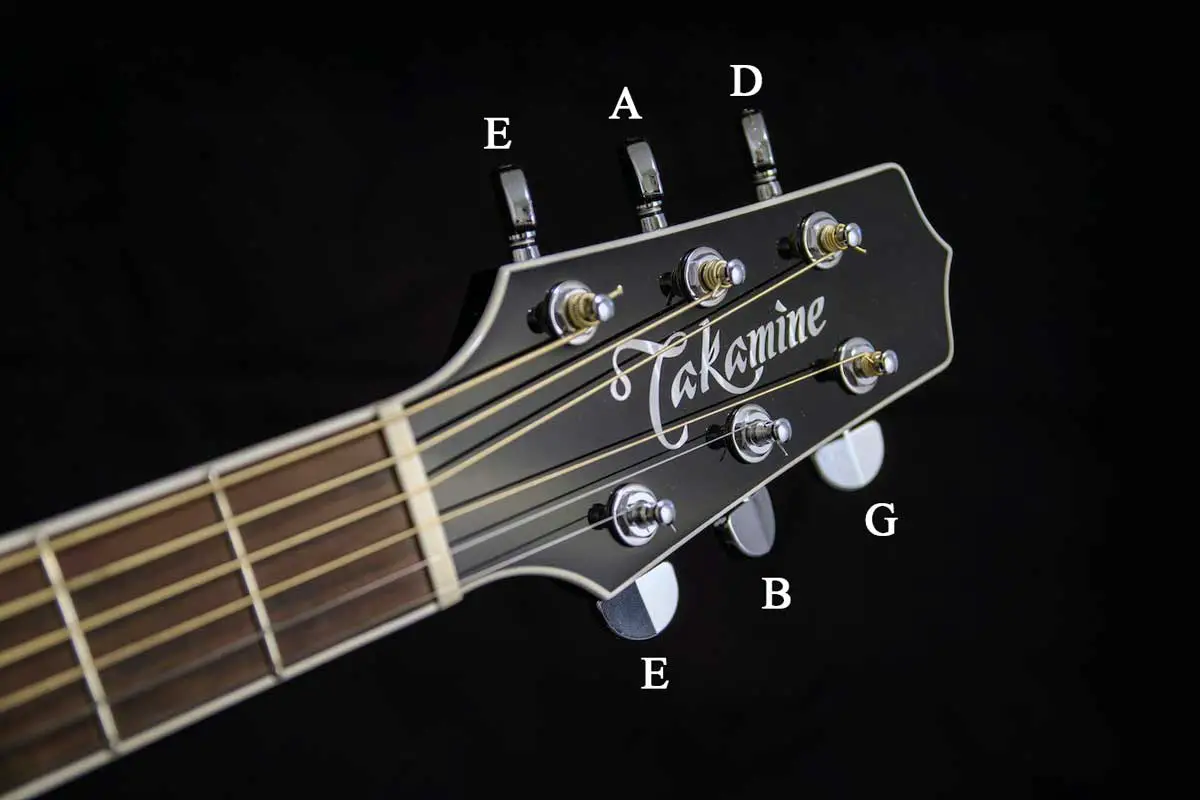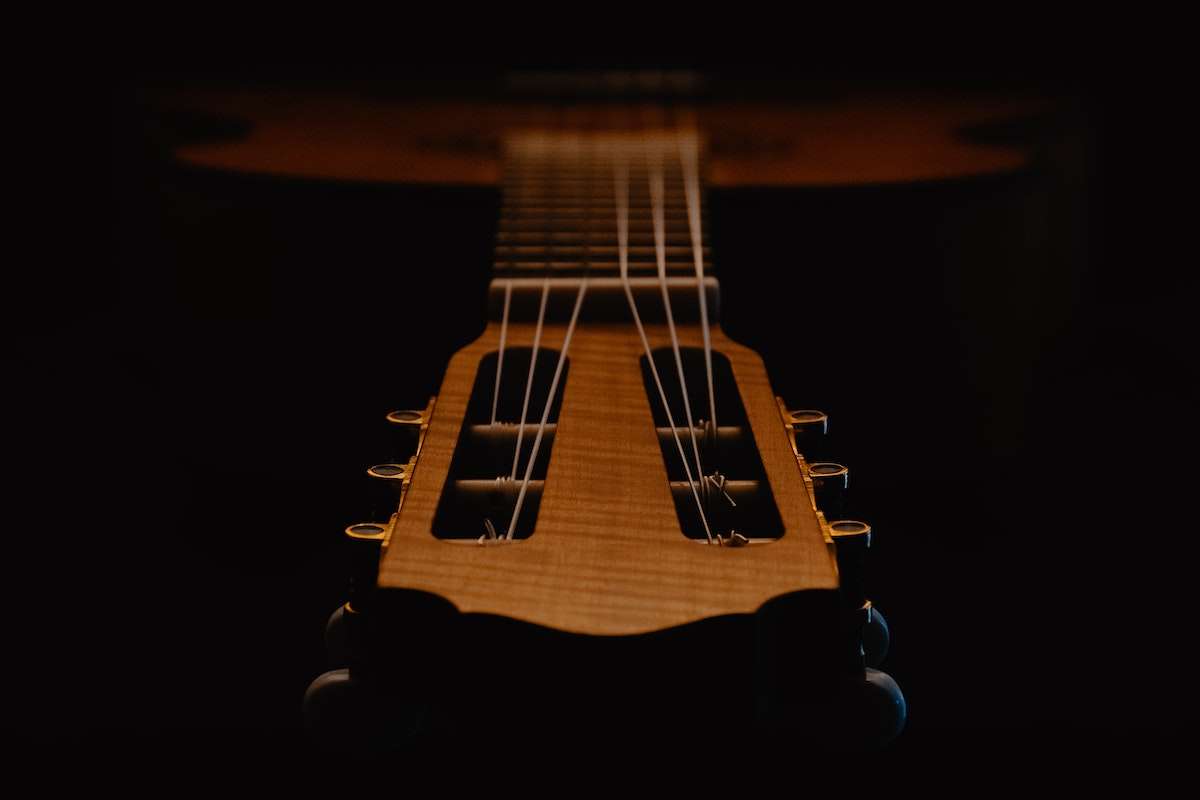Embarking on your guitar journey, you’ll soon discover that mastering standard guitar tuning, with its open string notes of EADGBE, is an indispensable skill that will stick with you indefinitely.
This guide meticulously navigates the essentials of fine-tuning each string & unpacks the history behind this ubiquitous tuning method. We’ll also arm you with robust memorization strategies to cement this core technique into your repertoire and offer savvy maintenance advice for impeccable tuning. The result? A newfound ability to weave melodies and chords with precision & poise.

E Standard Guitar Tuning Basics
In the world of guitar, E Standard Tuning reigns supreme, setting the open strings of the instrument to the notes EADGBE, from the lowest (thickest) string to the highest (thinnest). These open strings are so called because they resonate at their respective fundamental pitches when struck without being fretted.
This tuning system, a harmonious arrangement of perfect fourths with a single major third between the G and B strings, has become the bedrock of guitar playing. It facilitates a wide range of chords , melodies, arpeggios, and scales, making it a practical and versatile foundation for both beginners and seasoned players alike.

Remembering The Guitar String Names
Memorizing the names of the guitar strings in standard tuning—E, A, D, G, B, E—can be made simple and fun with mnemonic devices. These memory aids transform the string names into easy-to-remember phrases or sentences.
For example, one popular mnemonic for the standard tuning from the lowest (sixth) string to the highest (first) string is “Eddie Ate Dynamite, Good Bye Eddie.” Here’s a list of alternative mnemonics to help cater to different learning styles:
- Eat All Day, Get Big Easy
- Every Apple Does Go Bad Eventually
- Elephants And Donkeys Grow Big Ears
Choose the mnemonic that resonates with you, or create a unique phrase that you’ll easily recall. By repeatedly using the mnemonic during your practice sessions, you’ll find that the string names become second nature, allowing you to tune your guitar with confidence and ease.
How To Implement E Standard Guitar Tuning (Acoustic & Electric)
E standard guitar tuning is the gateway to playing most guitar music, and here’s how you can tune both acoustic and electric guitars:
- Start with the low E string (6th string) and tune it to the correct pitch using a tuner.
- Move to the A string (5th string) and either use a tuner or compare it to the fifth fret of the low E string, adjusting until they sound the same.
- For the D string (4th string), match the open D string to the fifth fret of the A string.
- Tune the G string (3rd string) by comparing it to the fifth fret of the D string.
- The B string (2nd string) is slightly different; tune it to match the fourth fret of the G string.
- Lastly, the high E string (1st string) should be tuned to match the fifth fret of the B string.
Check each string with your tuner again and make fine adjustments as necessary. A helpful tuning pitch video is provided below so you can match the sound pitches. Remember, your ears are your best tool, so use the video to train them and ensure your guitar string all sound in harmony.
Tips for Tuning Your Guitar Successfully
To tune your guitar successfully, start by familiarizing yourself with the correct pitch of each string to avoid over-tightening, which is a common mistake that can lead to string breakage.
Always tune from below the note, gradually increasing tension until you reach the desired pitch. This helps maintain the structural integrity of the string and minimizes the risk of snapping.
For added safety, regularly check the condition of your tuning pegs and nut, as burrs or rough edges can also cause strings to break. Here’s a simple data table to guide you through the standard tuning pitches:
| String Number | Note | Frequency (Hz) |
|---|---|---|
| 1 (High E) | E4 | 329.63 |
| 2 (B) | B3 | 246.94 |
| 3 (G) | G3 | 196.00 |
| 4 (D) | D3 | 146.83 |
| 5 (A) | A2 | 110.00 |
| 6 (Low E) | E2 | 82.41 |
Use this table as a reference to ensure each string is tuned to the correct frequency, and remember, patience and gradual adjustments are key to a well-tuned and intact guitar.
Finally, be sure to properly stretch you strings, especially after installing a fresh set of strings to improve your tuning stability.
Maintaining Your Guitar in Standard Tuning
Keeping your guitar consistently in standard tuning requires a combination of daily habits and an awareness of environmental factors. Make it a routine to check and fine-tune your guitar every time you play, as frequent adjustments can help the strings settle and maintain pitch. Additionally, be mindful of environmental conditions such as temperature and humidity, which can significantly affect tuning stability. Here’s a list of maintenance tips to help preserve your standard tuning:
- Tune Regularly: Integrate tuning into your daily practice routine.
- Store Properly: Keep your guitar in a stable environment, away from extreme temperatures and humidity changes.
- Use a Case: When not in use, store your guitar in a hard case to protect it from environmental shifts.
- Humidity Control: Consider using a humidifier or dehumidifier in the room where you store your guitar, if necessary.
- String Care: Wipe down your strings after playing to remove oils and residue that can corrode them.

Troubleshooting Common Tuning Problems
When you encounter tuning issues with your guitar, identifying the problem is the first step to finding a solution. If your guitar goes out of tune quickly after you’ve just tuned it, check for loose tuning pegs, worn strings, or an improperly seated string at the bridge or nut. These are common culprits that can cause instability in tuning. For instance, if the string is slipping at the tuning peg, it may need to be wound more securely or the peg itself might require tightening. Additionally, environmental factors like changes in humidity and temperature can cause wood to expand or contract, affecting tuning. Keep an eye on these conditions and adjust your tuning habits accordingly.
It’s also important to recognize when it’s time to change your guitar strings. Old or corroded strings can lose their elasticity and struggle to hold pitch. As a general guideline, strings should be changed every 3 months or 100 hours of play, whichever comes first. However, this can vary based on how often you play, your body chemistry, and whether you wipe down your strings after use. Here’s a data table to help you track string life and maintenance:
| String Age | Play Time (Hours) | Maintenance Check |
|---|---|---|
| 1 month | 25 | Check for tuning stability, wipe down strings |
| 2 months | 50 | Inspect for discoloration or kinks, retune |
| 3 months | 75-100 | Consider changing strings, ensure pegs are secure |
A Brief History of Standard Tuning On Guitar
The journey of E standard guitar tuning on the guitar is a tale woven through centuries of musical evolution. The concept of a ‘standard’ did not always exist; in the Renaissance period, guitarists often used varied tunings to suit different pieces.
It wasn’t until the mid-18th century that the familiar EADGBE tuning began to emerge, influenced by the six-course guitar (a precursor to the modern six-string instrument) which was commonly tuned to ADGBE for the top five strings.
This setup became more standardized as the guitar evolved into a six-string instrument and composers like Fernando Sor and Dionisio Aguado, prominent figures in the classical guitar world, began to favor this tuning for its versatility and the rich harmonic possibilities it offered.
To truly appreciate the establishment of EADGBE as the standard tuning, consider this timeline:
- Mid-1500s: The five-course ‘guitarra battente’ in Italy is tuned to ADGBE for the top five strings.
- Early 19th Century: The six-string guitar gains popularity, and the EADGBE tuning starts to become common.
- Mid-19th Century: The tuning is solidified as standard, as luthiers and musicians seek uniformity.
Today, EADGBE is not just a tuning; it’s a historical constant that has shaped the modern sound of the guitar, providing a common language for guitarists across genres and generations.
This tuning’s endurance is a testament to its practicality, allowing for a wide range of chords and scales to be played with relative ease. It’s a system that has stood the test of time, adapting to the changing styles and demands of guitar music.
Related: The history of the electric guitar

Comparing Standard Guitar Tuning to Other Common Tunings
E standard guitar tuning (EADGBE) serves as the foundational tuning system for guitarists, prized for its balance of range and playability.
- In contrast, Eb tuning (half step down) lowers each string by a half step for a darker tone often used in blues and rock.
- Drop D tuning, where only the lowest string is tuned down a whole step to D, facilitates power chords with single-finger barre shapes.
- Open D and Open F tunings rearrange all strings to form a D major and F major chord respectively when strummed open, favored for slide guitar and fingerstyle.
- D Standard tuning is a whole step down from standard, providing a heavier sound without altering the relative tuning of the strings.
- Drop C takes this a step further by dropping the lowest string to C.
- For extended range guitars, a 7-string typically adds a low B, and an 8-string adds a low F# (or E for a double drop). A 12-string guitar pairs each standard string with another an octave higher (except for the high E and B strings, which are in unison), creating a rich, chorused effect. The table below compares these tunings:
| Tuning | 1st String | 2nd String | 3rd String | 4th String | 5th String | 6th String | Additional Strings |
|---|---|---|---|---|---|---|---|
| Standard (E) | E | B | G | D | A | E | |
| Eb (Half Step Down) | Eb | Bb | Gb | Db | Ab | Eb | |
| Drop D | E | B | G | D | A | D | |
| Open D | D | A | F# | D | A | D | |
| D Standard | D | A | F | C | G | D | |
| Drop C | E | B | G | D | A | C | |
| Open F | F | C | A | F | C | F | |
| 7 String | E | B | G | D | A | E | B (7th String) |
| 8 String | E | B | G | D | A | E | B (7th), F# (8th) |
| 12 String | E (octave) | B (octave) | G (octave) | D (octave) | A (octave) | E (octave) | E, B, G, D, A (unison) |
Each tuning offers its unique flavor and technical possibilities, shaping the music created with it.

Frequently Asked Questions
What is the most common guitar tuning?
Standard tuning (EADGBE) is the most common guitar tuning used by most guitarists. It allows for easy chord shapes, scale patterns, and a vast repertoire of songs across various genres. Learning and mastering standard tuning provides a solid foundation for playing the guitar, accessing educational resources, collaborating with other musicians, and expanding musical possibilities.
Is standard guitar tuning 440 or 442?
Standard guitar tuning is based on A440, which is the internationally accepted standard pitch reference for tuning musical instruments. However, there can be variations in tuning depending on personal preference or specific musical contexts. Some musicians may choose to tune slightly higher or lower than A440, but A440 is the commonly accepted standard for standard guitar tuning.
What is the easiest tuning to play in?
E standard guitar tuning (E-A-D-G-B-E) is the easiest and most versatile tuning to start with. It provides a balanced layout of notes, chord shapes, scale patterns, educational resources, and a vast repertoire of songs to learn. It also provides a solid platform for exploring different tunings and musical styles in the future.
How to tune a 6 string without a tuner?
To tune a 6-string guitar without a tuner, begin with the low E string, adjusting it to a comfortable tension by ear. Then, use the fifth fret on each string to tune the next open string, except when tuning the B string, which should match the pitch of the fourth fret on the G string. Fine-tune as needed. This method won’t yield perfect pitch, but it will be sufficient for solo play.
